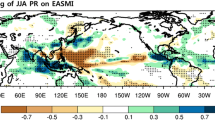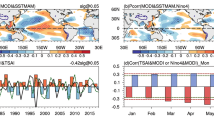Abstract
In this paper, the synergistic effect of the preceding winter positive Northern Hemisphere annular mode (pNAM) and spring negative tropical North Atlantic (nTNA) sea surface temperature anomaly (SSTA) on spring extreme cold events in the mid-high latitudes of East Asia (MHEA) is investigated. The results show that the co-occurrence of the two factors is unfavorable for extreme cold events during spring in the MHEA via the snow cover and atmospheric bridges. Over the Atlantic, the spring nTNA SSTA can lead to an atmospheric response that is similar to the North Atlantic Oscillation, which enhances the persistence of the pNAM and in turn amplifies the negative spring Eurasian snow cover extent (EASCE) anomaly caused by the preceding winter pNAM. Meanwhile, the spring EASCE is closely related to the spring MHEA anomalous anticyclone. In addition to storing its signal in the spring EASCE, the spring nTNA SSTA can also lead to the spring MHEA anomalous anticyclone via the eastward Rossby wave train. The evidence shows that the Rossby wave energy can propagate eastward to the MHEA as a result of the enhanced negative spring EASCE anomaly and Rossby wave induced by the spring nTNA SSTA, and the two factors have an obvious synergistic effect on the spring MHEA anomalous anticyclone. This anomalous MHEA anticyclone becomes a barrier that can hinder the intrusion of cold air from the polar region and can increase the thickness of the atmospheric layer. The anomalous sinking motion of the spring MHEA anomalous anticyclone can also lead to an increase in net radiation received at the surface and increase the air temperature through the vertical motion of air. The southerly wind over the west side of the spring MHEA anomalous anticyclone leads to horizontal warm advection. All of the above processes favor an increase in air temperature and dampen extreme cold events, implying the synergistic effect of the preceding winter pNAM and spring nTNA SSTA on spring extreme cold events in the MHEA.












Similar content being viewed by others
References
Bamzai A (2003) Relationship between snow cover variability and Arctic Oscillation index on a hierarchy of time scales. Int J Climatol 23(2):131–142
Chen TC, Yen MC, Huang WR, Gallus WA (2002) An East Asian cold surge: case study. Mon Weather Rev 130(9):2271–2290
Chen TC, Huang WR, Yoon J (2004) Interannual variation of the East Asian cold surge activity. J Clim 17(2):401–413
Chen S, Wu R, Liu Y (2016) Dominant modes of interannual variability in Eurasian surface air temperature during boreal spring. J Clim 29:1109–1125
Cheung HN, Zhou W, Mok HY, Wu MC (2012) Relationship between ural-Siberian blocking and the East Asian winter monsoon in relation to the Arctic Oscillation and the El Nino–Southern Oscillation. J Clim 25(12):4242–4257
Dunn RJH, Alexander LV, Donat MG et al (2020) Development of an updated global land in situ-based data set of temperature and precipitation extremes: HadEX3. J Geophys Res Atmos 125(16):e2019JD032263
Easterling DR (2000) Climate extremes: observations, modeling, and impacts. Science 289(5487):2068–2074
Gong DY, Ho CH (2002) The Siberian high and climate change over middle to high latitudeAsia. Theor Appl Climatol 72(1):1–9
Gong DY, Yang J, Kim SJ, Gao Y, Guo D, Zhou T, Hu M (2011) Spring Arctic Oscillation-East Asian summer monsoon connection through circulation changes over the western North Pacific. Clim Dyn 37:2199–2216
Hersbach H, Bell B, Berrisford P, Hirahara S, Horányi A, Muñoz-Sabater J et al (2020) The ERA5 global reanalysis. Q J R Meteorol Soc 146:1999–2049
Hoskins BJ, Karoly DJ (1981) The steady linear response of a spherical atmosphere to thermal and orographic forcing. J Atmos Sci 38:1179–1196
Huang J, Yu H, Guan X, Wang G, Guo R (2016) Accelerated dryland expansion under climate change. Nat Clim Change 6:166–171
Jeong J-H, Kim B-M, Ho C-H, Noh Y-H (2008) Systematic variation in wintertime precipitation in East Asia by MJO-induced extratropical vertical motion. J Clim 21(4):788–801
Kalnay E, Kanamitsu M, Kistler R et al (1996) The NCEP/NCAR 40-year reanalysis project. Bull Am Meteorol Soc 77(3):437–471
Karoly DJ (1983) Rossby wave propagation in a barotropic atmosphere. Dyn Atmos Oceans 7:111–125
Li SL (2004) Impact of northwest Atlantic SST anomalies on the circulation over the Ural Mountains during early winter. J Meteorol Soc Jpn 82:971–988
Li Y, Li JP (2012) Propagation of planetary waves in the horizontal non-uniform basic flow (in Chinese). Chin J Geophys 55(2):361–371
Li L, Nathan TR (1997) Effects of low-frequency tropical forcing on intraseasonal tropical-extratropical interactions. J Atmos Sci 54:332–346
Li JP, Ruan CQ (2018) The North Atlantic-Eurasian teleconnection in summer and its effects on Eurasian climates. Environ Res Lett 13:024007
Li JP, Wang JXL (2003) A modified zonal index and its physical sense. Geophys Res Lett 30:1632
Li JP, Wu ZW (2012) Importance of autumn Arctic sea ice to northern winter snowfall. Proc Natl Acad Sci 109:E1898
Li Y, Li JP, Jin FF, Zhao S (2015) Interhemispheric propagation of stationary Rossby waves in the horizontally nonuniform background flow. J Atmos Sci 72(8):3233–3256
Li JP, Zheng F, Sun C, Feng J, Wang J (2019a) Pathways of influence of the Northern Hemisphere mid-high latitudes on East Asian climate: a review. Adv Atmos Sci 36:902–921
Li Y, Feng J, Li JP, Hu X (2019b) Equatorial windows and barriers for stationary Rossby wave propagation. J Clim 32:6117–6135
Li JP, Xie TJ, Tang XX, Wang H, Sun C, Feng J, Zheng F, Ding RQ (2021) Influence of the NAO on wintertime surface air temperature over the East Asia: multidecadal variability and decadal prediction. Adv Atmos Sci 39:625–642
Lin J, Wu B, Zhou T (2016) Is the interdecadal circumglobal teleconnection pattern excited by the Atlantic multidecadal Oscillation? Atmos Ocean Sci Lett 9:451–457
Liu YY, Wang L, Zhou W, Chen W (2014) Three Eurasian teleconnection patterns: spatial structures, temporal variability, and associated winter climate anomalies. Clim Dyn 42:2817–2839
Liu S, Wu Q, Wang L, Schroeder SR, Zhang Y, Yao Y, Hu H (2020) Modeled climate responses to realistic extremes of Northern Hemisphere Spring and Summer snow anomalies. J Clim 33(22):9905–9927
Matsumura S, Yamazaki K (2012) Eurasian subarctic summer climate in response to anomalous snow cover. J Clim 25(4):1305–1317
Matsumura S, Yamazaki K, Tokioka T (2010) Summertime land–atmosphere interactions in response to anomalous springtime snow cover in northern Eurasia. J Geophys Res Atmos (1984–2012) 115(D20):D20107
Matsumura S, Yamazaki L, Sato T (2015) Role of Siberian land–atmosphere coupling in the development of the August Okhotsk High in 2008. J Meteorol Soc Jpn 93:229–244
Monerie P-A, Robson J, Dong B, Dunstone N (2017) A role of the Atlantic Ocean in predicting summer surface air temperature over North East Asia? Clim Dyn 51:473–491
Morice CP, Kennedy JJ, Rayner NA, Jones PD (2012) Quantifying uncertainties in global and regional temperature change using an ensemble of observational estimates: the HadCRUT4 dataset. J Geophys Res 117:D08101
Park TW, Jeong JH, Ho CH, Kim SJ (2008) Characteristics of atmospheric circulation associated with cold surge occurrences in East Asia: a case study during 2005/06 winter. Adv Atmos Sci 25(5):791–804
Park TW, Ho CH, Deng Y (2014) A synoptic and dynamical characterization of wave-train and blocking cold surge over East Asia. Clim Dyn 43(3):753–770
Qiao S, Feng G (2016) Impact of the December North Atlantic Oscillation on the following February East Asian trough. J Geophys Res 121:10074–10088
Rayner NA, Parker DE, Horton EB, Folland CK, Alexander LV, Rowell DP, Kent EC, Kaplan A (2003) Global analyses of sea surface temperature, sea ice, and night marine air temperature since the late nineteenth century. J Geophys Res 108:4407
Robinson DA, Estilow TW, Program NOAACDR (2012) NOAA Climate Data Record (CDR) of Northern Hemisphere (NH) Snow Cover Extent (SCE), version 1. NOAA Natl Cent Environ Inf
Robock A, Mu M, Vinnikov K, Robinson D (2003) Land surface conditions over Eurasia and Indian summer monsoon rainfall. J Geophys Res Atmos 108:4131
Saito K, Cohen J (2003) The potential role of snow cover in forcing interannual variability of the major Northern Hemisphere mode. Geo Res Lett 30(6):1302
Saito K, Yasunari T, Cohen J (2004) Changes in the sub-decadal covariability between Northern Hemisphere snow cover and the general circulation of the atmosphere. Int J Climatol 24(1):33–44
Screen JA, Simmonds I (2013) Exploring links between Arctic amplification and mid-latitude weather. Geophys Res Lett 40:959–964
Sun C, Li J, Zhao S (2015) Remote influence of Atlantic multidecadal variability on Siberian warm season precipitation. Sci Rep 5:16853
Sun Y, Li JP (2022) Synergistic effect of El Niño and the North Pacific Oscillation on wintertime precipitation over southeastern China and the East China Sea Kuroshio area. Clim Dyn 58:1635–1649
Takaya K, Nakamura H (2001) A formulation of a phase-independent wave activity flux for stationary and migratory quasi geostrophic eddies on a zonally varying basic flow. J Atmos Sci 58:608–627
Thompson DW, Wallace JM (1998) The Arctic Oscillation signature in the wintertime geopotential height and temperature fields. Geophys Res Lett 25:1297–1300
Thompson DW, Wallace JM (2000) Annular modes in the extratropical circulation. Part I: month-to-month variability. J Clim 13:1000–1016
Wallace JM, Gutzler DS (1981) Teleconnections in the geopotential height field during the Northern Hemisphere winter. Mon Weather Rev 109:784–812
Watanabe M, Kimoto M (2000) Atmosphere-ocean thermal coupling in the North Atlantic: a positive feedback. Q J R Meteorol Soc 126:3343–3369
Whitham G (1960) A note on group velocity. J Fluid Mech 9:347–352
Wu L, He F, Liu Z, Li C (2007) Atmospheric teleconnections of tropical Atlantic variability: interhemispheric, tropical–extratropical, and cross-basin interactions. J Clim 20:856–870
Wu R, Yang S, Liu S et al (2011) Northeast China summer temperature and North Atlantic SST. J Geophys Res 116:D16116
Wu B, Lin J, Zhou T (2016) Interdecadal circumglobal teleconnection pattern during boreal summer. Atmos Sci Lett 17:446–452
Xin X, Zhang L, Zhang J, Wu T, Fang Y (2013) Climate change projections over East Asia with BCC_CSM1.1 climate model under RCP scenarios. J Meteorol Soc Jpn 91(4):413–429
Ye KH, Lau NC (2019) Characteristics of Eurasian snowmelt and its impacts on the land surface and surface climate. Clim Dyn 52:1115–1138
Yin S, Feng J, Li JP (2013) Influences of the preceding winter Northern Hemisphere annular mode on the spring extreme low temperature events in the north of eastern China (in Chinese with English abstract). Acta Meteorol Sin 71(1):96–108
Zhang C, Wu R, Wang Z (2019) Impacts of summer North Atlantic sea surface temperature anomalies on the East Asian winter monsoon variability. J Clim 32(19):6513–6532
Zhao S, Li JP, Li Y (2015) Dynamics of an interhemispheric teleconnection across the critical latitude through a southerly duct during boreal winter. J Clim 28(19):7437–7456
Zhao S, Li JP, Li Y, Jin F-F, Zheng J (2019) Interhemispheric influence of Indo-Pacific convection oscillation on Southern Hemisphere rainfall through southward propagation of Rossby waves. Clim Dyn 52(5–6):3203–3221
Zhou J, Zuo Z, He Q (2021) Influence of Eurasian spring snowmelt on surface air temperature in late spring and early summer. J Clim 34(20):8191–8204
Acknowledgements
Hao Wang and Yina Diao contributed equally to this work. We wish to thank all the data providers, and the two anonymous reviewers for the valuable suggestions and comments. This work is supported by the National Natural Science Foundation of China (NSFC) Project (41790474), Shandong Natural Science Foundation Project (ZR2019ZD12), and Fundamental Research Funds for the Central Universities (201962009). Dr. Fei Zheng is surported by China Association for Science and Technology Working Group for UN Environment Consultation. We are grateful to Center for High Performance Computing and System Simulation, Pilot National Laboratory for Marine Science and Technology (Qingdao) for providing computing resource.
Author information
Authors and Affiliations
Corresponding authors
Additional information
Publisher's Note
Springer Nature remains neutral with regard to jurisdictional claims in published maps and institutional affiliations.
Rights and permissions
About this article
Cite this article
Wang, H., Zheng, F., Diao, Y. et al. The synergistic effect of the preceding winter Northern Hemisphere annular mode and spring tropical North Atlantic SST on spring extreme cold events in the mid-high latitudes of East Asia. Clim Dyn 59, 3175–3191 (2022). https://doi.org/10.1007/s00382-022-06237-w
Received:
Accepted:
Published:
Issue Date:
DOI: https://doi.org/10.1007/s00382-022-06237-w




